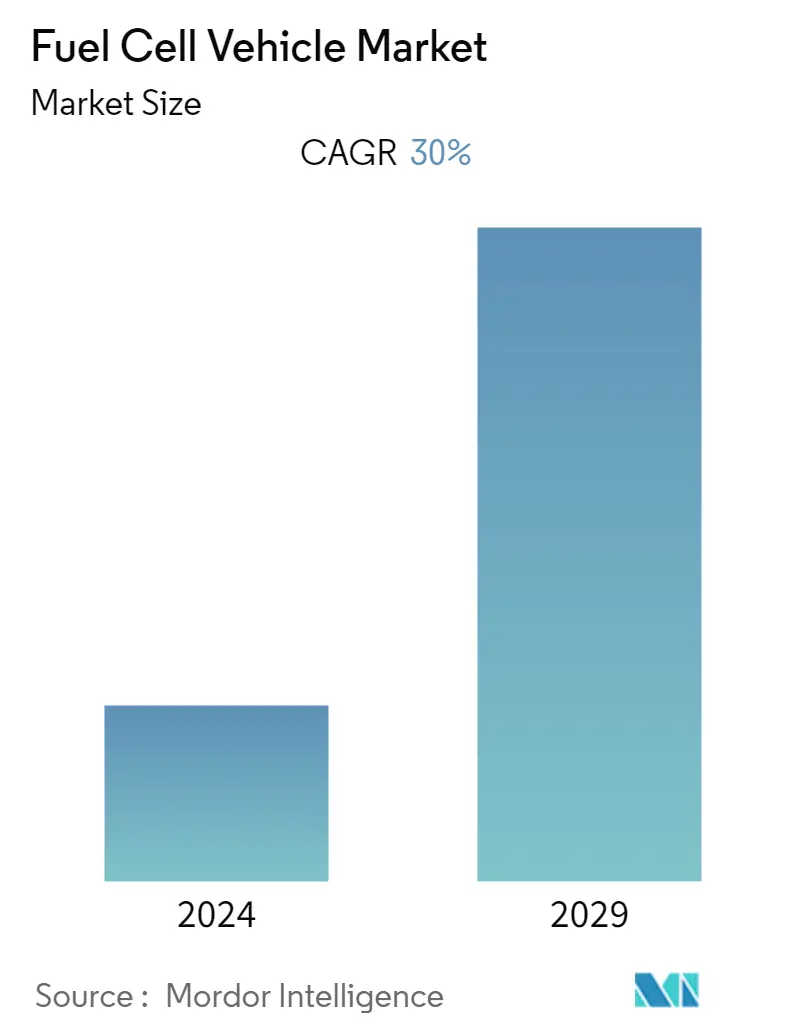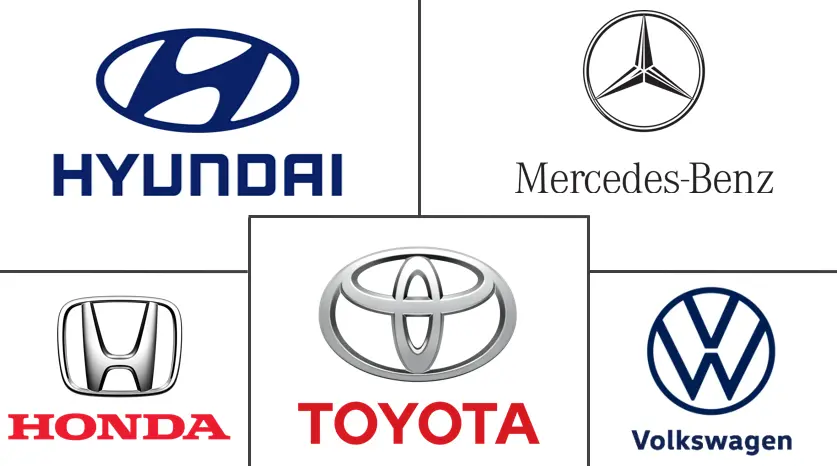Market Size of Fuel Cell Vehicle Industry

| Study Period | 2019 - 2029 |
| Base Year For Estimation | 2023 |
| CAGR | 30.00 % |
| Fastest Growing Market | Asia-Pacific |
| Largest Market | Asia-Pacific |
| Market Concentration | High |
Major Players
*Disclaimer: Major Players sorted in no particular order |
Fuel Cell Vehicle Market Analysis
The Fuel Cell Vehicle Market was valued at USD 400 million in 2021, and it is expected to reach USD 8,500 million by 2027, registering a CAGR of around 30% during the forecast period (2022-2027).
COVID-19's influence on the fuel cell vehicle market was unavoidable, as it has on nearly every other industry in the market. However, due to the rapidly increasing adoption rate of mild-hybrid electric cars throughout the world, the electric vehicle (EV) industry is seeing significant growth. Additionally, due to the pandemic, sales of fuel cell vehicles decreased dramatically globally. However, with life returning to normalcy, the market is expected to gain momentum in the following years.
Factors such as rising fuel prices and government activities throughout the globe to raise awareness about fuel cell electric cars are projected to drive the use of electric vehicles over the forecast period. Infrastructure for hydrogen stations continues to improve, and nations like China, which have a well-established supply chain for components such as traction motors, fuel cells, and others continue to lead the passenger car and urban bus sectors.
The expansion of the fuel cell electric vehicle market is fueled by increased demand for fuel-efficient, high-performance, and low-emission cars, as well as stricter rules and regulations on vehicle emissions, decreased battery costs, and rising fuel costs.
Governments all across the world are getting increasingly interested in electric mobility. Government rules to phase out fossil fuel-powered vehicles, government expenditures to improve public EV charging infrastructure, and measures like subsidies and tax refunds to stimulate the adoption of EVs are all expected to aid market expansion. Several governments across the globe are investing in electric vehicle infrastructure, including hydrogen filling stations directly through public filing stations and also through subsidies.
Fuel Cell Vehicle Industry Segmentation
The main source of fuel cell electric vehicles is hydrogen. The Vehicles running on hydrogen are powered by a fuel cell that replaced the conventional IC engine. These are more fuel-efficient than traditional internal combustion engines and release no tailpipe emissions but only water vapor and warm air. FCEVs and the hydrogen infrastructure needed to fuel them are still in their infancy. But with advancing technology, the global fuel cell market is expected to grow in the forecast period.
The market is segmented by Vehicle Type (Passenger Car and Commercial Vehicle), and by Geography (North America, Europe, Asia-Pacific, South America, and the Middle-East and Africa). The report offers market size and forecasts for Fuel Cell Vehicle Market in USD million for all the above segments.
| By Vehicle type | |
| Passenger Vehicle | |
| Commercial Vehicle |
| Geography | ||||||||
| ||||||||
| ||||||||
| ||||||||
| ||||||||
|
Fuel Cell Vehicle Market Size Summary
The fuel cell vehicle market is poised for significant growth, driven by increasing global adoption of electric vehicles and supportive government policies. The market is experiencing a resurgence as life returns to normal post-COVID-19, with rising fuel prices and heightened awareness of fuel cell electric cars propelling demand. The development of hydrogen infrastructure, particularly in countries like China, South Korea, and Japan, is crucial in supporting this growth. These nations are leading the charge with well-established supply chains and substantial investments in hydrogen refueling stations, which are essential for the widespread adoption of fuel cell vehicles. The market's expansion is further supported by stricter emissions regulations and a growing emphasis on fuel-efficient, high-performance, and low-emission vehicles.
Government initiatives play a pivotal role in the market's growth, with many countries implementing plans to phase out fossil fuel-powered vehicles and offering incentives to encourage the adoption of fuel cell vehicles. These efforts are aimed at reducing vehicle emissions and improving air quality, addressing the significant contribution of vehicle pollution to overall air pollution. Despite challenges such as limited hydrogen refueling infrastructure and higher costs compared to traditional electric vehicles, the market is expected to benefit from collaborations among major automotive players and ongoing technological advancements. The concentration of market share among key players like Hyundai, Volkswagen, Honda, Toyota, and Mercedes-Benz underscores the competitive landscape, with partnerships and innovations driving the development of fuel cell electric vehicle technology.
Fuel Cell Vehicle Market Size - Table of Contents
-
1. MARKET DYNAMICS
-
1.1 Market Drivers
-
1.2 Market Restraints
-
1.3 Porter's Five Forces Analysis
-
1.3.1 Threat of New Entrants
-
1.3.2 Bargaining Power of Buyers/Consumers
-
1.3.3 Bargaining Power of Suppliers
-
1.3.4 Threat of Substitute Products
-
1.3.5 Intensity of Competitive Rivalry
-
-
-
2. MARKET SEGMENTATION
-
2.1 By Vehicle type
-
2.1.1 Passenger Vehicle
-
2.1.2 Commercial Vehicle
-
-
2.2 Geography
-
2.2.1 North America
-
2.2.1.1 US
-
2.2.1.2 Canada
-
2.2.1.3 Rest of North America
-
-
2.2.2 Europe
-
2.2.2.1 Germany
-
2.2.2.2 UK
-
2.2.2.3 France
-
2.2.2.4 Russia
-
2.2.2.5 Spain
-
2.2.2.6 Rest of Europe
-
-
2.2.3 Asia-Pacific
-
2.2.3.1 India
-
2.2.3.2 China
-
2.2.3.3 Japan
-
2.2.3.4 South Korea
-
2.2.3.5 Rest of Asia-Pacific
-
-
2.2.4 South America
-
2.2.4.1 Brazil
-
2.2.4.2 Argentina
-
2.2.4.3 Rest of South America
-
-
2.2.5 Middle-East and Africa
-
2.2.5.1 UAE
-
2.2.5.2 Saudi Arabia
-
2.2.5.3 Rest of Middle-East and Africa
-
-
-
Fuel Cell Vehicle Market Size FAQs
What is the current Fuel Cell Vehicle Market size?
The Fuel Cell Vehicle Market is projected to register a CAGR of 30% during the forecast period (2024-2029)
Who are the key players in Fuel Cell Vehicle Market?
Volkswagen AG, Mercedes-Benz Group, Honda Motor Company Limited, Hyundai Motor Company and Toyota Motor Corporation are the major companies operating in the Fuel Cell Vehicle Market.

